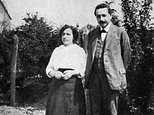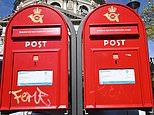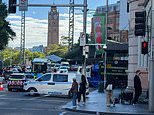
A remarkable cache of love letters from Albert Einstein to his first wife have revealed details of secret daughter – but the penned notes also told a tale of heartache.
The genius mathematician told Mileva Maric that he is ‘very sorry about what happened with Lieserl’.
‘Scarlet fever often leaves some lasting trace behind,’ Einstein, who was known to have two sons, wrote.
Mileva is believed to have fallen pregnant during a stay in Lake Como and gave birth to their daughter in early 1902 – but his family had tried to keep them apart.
After her birth, a proud Einstein sent sweet letters asking ‘What kind of little eyes does she have? Whom of us two does she resemble more?’
The letters also revealed his raunchy as he told Mileva in one eyebrow-raising letter he couldn’t wait for her to visit him in Lake Como so they could ‘wrap together in his dressing gown’.
Einstein also provided glimpses of his ingenious thinking while discussing his early academic career in the collection of 43 letters dating from 1898 to 1903.
Einstein’s love letters are being sold at Christie’s and have a valuation of up to £1million.
A remarkable cache of love letters from Albert Einstein (pictured) to his first wife revealing his raunchy side have emerged for sale for £1m
In April 1901 he told Mileva (pictured, left) of his excitement at her impending visit to Lake Como, writing suggestively: ‘Come to me to Como and bring along my blue dressing-gown, into which we can wrap ourselves’
The letters give an insight into Einstein – and his families’ lives
In one letter he wrote: ‘My broodings about radiation are starting to get on somewhat firmer ground.’
In another, he stated: ‘I am more and more convinced that the electrodynamics of moving bodies, as presented today, is not correct, and that it should be possible to present it in a simpler way.’
He expanded on this theory in his groundbreaking 1905 paper on Special Relativity.
The letters to his ‘doll’, which are signed ‘Albert’ and written in an old German gothic style, are set to spark a bidding war at auctioneers Christie’s, of London.
Einstein was a 16-year-old student at Zurich Polytechnic in Switzerland when he met Mileva, one of the earliest female pupils on the physics and mathematics course.
Mileva, who was Serbian, was three years older then Einstein and their first letters in 1898 were quite formal.
As time passed, the letters reveal their relationship becoming personal, to the disapproval to Einstein’s family.
Einstein confided in Mileva that his mother told him: ‘You are ruining your future…That woman cannot gain entrance to a decent family.’
But Einstein, displaying his stubborn streak, ignored her pleas and by the beginning of 1901 was applying for teaching posts so he could earn enough money to marry Mileva.
In April 1901, he told Mileva of his excitement at her impending visit to Lake Como, writing suggestively: ‘Come to me to Como and bring along my blue dressing-gown, into which we can wrap ourselves.’
Einstein provided glimpses of his ingenious thinking while discussing his early academic career in the collection of 43 letters dating from 1898 to 1903
Einstein was a 16-year-old student at Zurich Polytechnic in Switzerland when he met Mileva, one of the earliest female pupils on the physics and mathematics course
In a letter from that October, Einstein shared his excitement at impending fatherhood and refers to their unborn baby as Lieserl.
Mileva gave birth to their daughter in 1902, by when Einstein was settled in Bern and waiting to start his job at the Patent Office.
On February 4, 1902, he proudly wrote: ‘You see, it has really turned out to be a Lieserl, as you wished.
‘Is she healthy and does she already cry properly?
‘What kind of little eyes does she have? Whom of us two does she resemble more?’
Einstein and Mileva married in January 1903 and the last letter references her second pregnancy, a son named Hans Albert.
He also mentions that Leiserl had been ill with scarlet fever, which tragically is thought to have killed her shortly afterwards.
Einstein and Mileva had a third child, Eduard, in 1910 but they divorced in 1919 after she learnt that he had been unfaithful with his cousin, Elsa Lowenthal.
He was awarded the Nobel Prize for physics two years later and, as agreed in the divorce settlement, gave Mileva his winnings.
The letters remained in the family until they were sold at auction in 1996, where the vendor acquired them.
The auctioneers say that it is extremely rare to find Einstein correspondence from before 1905 which reveal so much about his ‘formative’ years.
Thomas Venning, manuscripts specialist at Christie’s, said: ‘The letters give you the whole picture on what Albert Einstein was like in his formative years.
‘It is very rare to find letters from him pre-1905 and for it to be such significant correspondence, to such a significant recipient, is just wonderful.
‘Even though he was just a teenager when he began writing them, you sense that he was already asking questions on different areas of physics.
‘He would not just accept previous scientific thought and wanted instead to push the boundaries and challenge conventions.’
Einstein died in 1955.
The sale takes place on December 11.





